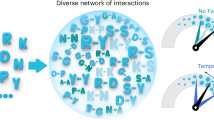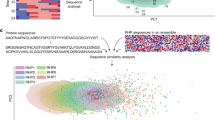Abstract
Proteins and synthetic polymers that undergo aqueous phase transitions mediate self-assembly in nature and in man-made material systems. Yet little is known about how the phase behaviour of a protein is encoded in its amino acid sequence. Here, by synthesizing intrinsically disordered, repeat proteins to test motifs that we hypothesized would encode phase behaviour, we show that the proteins can be designed to exhibit tunable lower or upper critical solution temperature (LCST and UCST, respectively) transitions in physiological solutions. We also show that mutation of key residues at the repeat level abolishes phase behaviour or encodes an orthogonal transition. Furthermore, we provide heuristics to identify, at the proteome level, proteins that might exhibit phase behaviour and to design novel protein polymers consisting of biologically active peptide repeats that exhibit LCST or UCST transitions. These findings set the foundation for the prediction and encoding of phase behaviour at the sequence level.
This is a preview of subscription content, access via your institution
Access options
Subscribe to this journal
Receive 12 print issues and online access
$259.00 per year
only $21.58 per issue
Buy this article
- Purchase on Springer Link
- Instant access to full article PDF
Prices may be subject to local taxes which are calculated during checkout






Similar content being viewed by others
References
Li, P. et al. Phase transitions in the assembly of multivalent signalling proteins. Nature 483, 336–340 (2012).
Kato, M. et al. Cell-free formation of RNA granules: Low complexity sequence domains form dynamic fibers within hydrogels. Cell 149, 753–767 (2012).
Weber, S. C. & Brangwynne, C. P. Getting RNA and protein in phase. Cell 149, 1188–1191 (2012).
Vekilov, P. G. Phase transitions of folded proteins. Soft Matter 6, 5254–5272 (2010).
Toretsky, J. A. & Wright, P. E. Assemblages: Functional units formed by cellular phase separation. J. Cell Biol. 206, 579–588 (2014).
Frey, S., Richter, R. P. & Görlich, D. FG-rich repeats of nuclear pore proteins form a three-dimensional meshwork with hydrogel-like properties. Science 314, 815–817 (2006).
Roy, D., Brooks, W. L. & Sumerlin, B. S. New directions in thermoresponsive polymers. Chem. Soc. Rev. 42, 7214–7243 (2013).
Stuart, M. A. C. et al. Emerging applications of stimuli-responsive polymer materials. Nature Mater. 9, 101–113 (2010).
McDaniel, J. R. et al. Self-assembly of thermally responsive nanoparticles of a genetically encoded peptide polymer by drug conjugation. Angew. Chem. Int. Ed. 52, 1683–1687 (2013).
MacKay, J. A. et al. Self-assembling chimeric polypeptide–doxorubicin conjugate nanoparticles that abolish tumours after a single injection. Nature Mater. 8, 993–999 (2009).
Liu, W. et al. Brachytherapy using injectable seeds that are self-assembled from genetically encoded polypeptides in situ. Cancer Res. 72, 5956–5965 (2012).
Nishida, K. et al. Corneal reconstruction with tissue-engineered cell sheets composed of autologous oral mucosal epithelium. New Eng. J. Med. 351, 1187–1196 (2004).
Caves, J. M. et al. Elastin-like protein matrix reinforced with collagen microfibers for soft tissue repair. Biomaterials 32, 5371–5379 (2011).
Koria, P. et al. Self-assembling elastin-like peptides growth factor chimeric nanoparticles for the treatment of chronic wounds. Proc. Natl Acad. Sci. USA 108, 1034–1039 (2011).
Meyer, D. E. & Chilkoti, A. Purification of recombinant proteins by fusion with thermally-responsive polypeptides. Nature Biotechnol. 17, 1112–1115 (1999).
Bellucci, J. J., Amiram, M., Bhattacharyya, J., McCafferty, D. & Chilkoti, A. Three-in-one chromatography-free purification, tag removal, and site-specific modification of recombinant fusion proteins using sortase A and elastin-like polypeptides. Angew. Chem. Int. Ed. 52, 3703–3708 (2013).
Stayton, P. S. et al. Control of protein–ligand recognition using a stimuli-responsive polymer. Nature 378, 472–474 (1995).
Dill, K. A. & MacCallum, J. L. The protein-folding problem, 50 years on. Science 338, 1042–1046 (2012).
Habchi, J., Tompa, P., Longhi, S. & Uversky, V. N. Introducing protein intrinsic disorder. Chem. Rev. 114, 6561–6588 (2014).
Li, N. K., Quiroz, F. G., Hall, C. K., Chilkoti, A. & Yingling, Y. G. Molecular description of the LCST behaviour of an elastin-like polypeptide. Biomacromolecules 15, 3522–3530 (2014).
Muiznieks, L. D. & Keeley, F. W. Proline periodicity modulates the self-assembly properties of elastin-like polypeptides. J. Biol. Chem. 285, 39779–39789 (2010).
Dutta, N. K. et al. A genetically engineered protein responsive to multiple stimuli. Angew. Chem. Int. Ed. 50, 4428–4431 (2011).
Rauscher, S., Baud, S., Miao, M., Keeley, F. W. & Pomès, R. Proline and glycine control protein self-organization into elastomeric or amyloid fibrils. Structure 14, 1667–1676 (2006).
De Las Heras Alarcon, C., Pennadam, S. & Alexander, C. Stimuli responsive polymers for biomedical applications. Chem. Soc. Rev. 34, 276–285 (2005).
Amiram, M., Quiroz, F. G., Callahan, D. J. & Chilkoti, A. A highly parallel method for synthesizing DNA repeats enables the discovery of ‘smart’ protein polymers. Nature Mater. 10, 141–148 (2011).
Balu, R. et al. An16-resilin: An advanced multi-stimuli-responsive resilin-mimetic protein polymer. Acta Biomater. 10, 4768–4777 (2014).
Urry, D. W. et al. Hydrophobicity scale for proteins based on inverse temperature transitions. Biopolymers 32, 1243–1250 (1992).
Das, R. K. & Pappu, R. V. Conformations of intrinsically disordered proteins are influenced by linear sequence distributions of oppositely charged residues. Proc. Natl Acad. Sci. USA 110, 13392–13397 (2013).
Yokoi, H., Kinoshita, T. & Zhang, S. Dynamic reassembly of peptide RADA16 nanofiber scaffold. Proc. Natl Acad. Sci. USA 102, 8414–8419 (2005).
Müller-Späth, S. et al. Charge interactions can dominate the dimensions of intrinsically disordered proteins. Proc. Natl Acad. Sci. USA 107, 14609–14614 (2010).
Möglich, A., Joder, K. & Kiefhaber, T. End-to-end distance distributions and intrachain diffusion constants in unfolded polypeptide chains indicate intramolecular hydrogen bond formation. Proc. Natl Acad. Sci. USA 103, 12394–12399 (2006).
Meyer, D. E. & Chilkoti, A. Genetically encoded synthesis of protein-based polymers with precisely specified molecular weight and sequence by recursive directional ligation: Examples from the elastin-like polypeptide system. Biomacromolecules 3, 357–367 (2002).
Seuring, J. & Agarwal, S. First example of a universal and cost-effective approach: Polymers with tunable upper critical solution temperature in water and electrolyte solution. Macromolecules 45, 3910–3918 (2012).
Shimada, N. et al. Ureido-derivatized polymers based on both poly (allylurea) and poly (L-citrulline) exhibit UCST-type phase transition behaviour under physiologically relevant conditions. Biomacromolecules 12, 3418–3422 (2011).
Seuring, J. & Agarwal, S. Polymers with upper critical solution temperature in aqueous solution: Unexpected properties from known building blocks. ACS Macro Lett. 2, 597–600 (2013).
Seuring, J. & Agarwal, S. Polymers with upper critical solution temperature in aqueous solution. Macromol. Rapid Commun. 33, 1898–1920 (2012).
Azzaroni, O., Brown, A. A. & Huck, W. T. UCST wetting transitions of polyzwitterionic brushes driven by self-association. Angew. Chem. 118, 1802–1806 (2006).
Lowe, A. B. & McCormick, C. L. Synthesis and solution properties of zwitterionic polymers. Chem. Rev. 102, 4177–4190 (2002).
Mason, P., Neilson, G., Dempsey, C., Barnes, A. & Cruickshank, J. The hydration structure of guanidinium and thiocyanate ions: Implications for protein stability in aqueous solution. Proc. Natl Acad. Sci. USA 100, 4557–4561 (2003).
Mahadevi, A. S. & Sastry, G. N. Cation-π interaction: Its role and relevance in chemistry, biology, and material science. Chem. Rev. 113, 2100–2138 (2013).
Kao, W. J., Lee, D., Schense, J. C. & Hubbell, J. A. Fibronectin modulates macrophage adhesion and FBGC formation: The role of RGD, PHSRN, and PRRARV domains. J. Biomed. Mater. Res. 55, 79–88 (2001).
Iwamoto, Y. et al. YIGSR, a synthetic laminin pentapeptide, inhibits experimental metastasis formation. Science 238, 1132–1134 (1987).
Pierschbacher, M. D. & Ruoslahti, E. Cell attachment activity of fibronectin can be duplicated by small synthetic fragments of the molecule. Nature 309, 30–33 (1983).
Lee, B. W. et al. Strongly binding cell-adhesive polypeptides of programmable valencies. Angew. Chem. Int. Ed. 49, 1971–1975 (2010).
van der Lee, R. et al. Classification of intrinsically disordered regions and proteins. Chem. Rev. 114, 6589–6631 (2014).
Brassart, B. et al. Conformational dependence of collagenase (matrix metalloproteinase-1) up-regulation by elastin peptides in cultured fibroblasts. J. Biol. Chem. 276, 5222–5227 (2001).
Dreher, M. R. et al. Temperature triggered self-assembly of polypeptides into multivalent spherical micelles. J. Am. Chem. Soc. 130, 687–694 (2008).
Callahan, D. J. et al. Triple stimulus-responsive polypeptide nanoparticles that enhance intratumoral spatial distribution. Nano Lett. 12, 2165–2170 (2012).
Crick, S. L., Ruff, K. M., Garai, K., Frieden, C. & Pappu, R. V. Unmasking the roles of N-and C-terminal flanking sequences from exon 1 of huntingtin as modulators of polyglutamine aggregation. Proc. Natl Acad. Sci. USA 110, 20075–20080 (2013).
Bates, F. S. et al. Multiblock polymers: Panacea or Pandora’s box? Science 336, 434–440 (2012).
Hassouneh, W., Zhulina, E. B., Chilkoti, A. & Rubinstein, M. Elastin-like polypeptide diblock copolymers self-assemble into weak micelles. Macromolecules 48, 4183–4195 (2015).
Tong, R., Chiang, H. H. & Kohane, D. S. Photoswitchable nanoparticles for in vivo cancer chemotherapy. Proc. Natl Acad. Sci. USA 110, 19048–19053 (2013).
Wong, C. et al. Multistage nanoparticle delivery system for deep penetration into tumor tissue. Proc. Natl Acad. Sci. USA 108, 2426–2431 (2011).
Clark, J. I. Self-assembly of protein aggregates in ageing disorders: The lens and cataract model. Phil. Trans. R. Soc. B 368, 20120104 (2013).
Smith, F. J. et al. Loss-of-function mutations in the gene encoding filaggrin cause ichthyosis vulgaris. Nature Genet. 38, 337–342 (2006).
Kyte, J. & Doolittle, R. F. A simple method for displaying the hydropathic character of a protein. J. Mol. Biol. 157, 105–132 (1982).
McDaniel, J. R., MacKay, J. A., Quiroz, F. G. & Chilkoti, A. Recursive directional ligation by plasmid reconstruction allows rapid and seamless cloning of oligomeric genes. Biomacromolecules 11, 944–952 (2010).
Acknowledgements
F.G.Q. thanks K. Zhu for his assistance with the preparation of Fig. 4d. This work was funded by the NIH through grant # GM061232 to A.C. and by the NSF through the Research Triangle MRSEC (NSF DMR-11-21107).
Author information
Authors and Affiliations
Contributions
F.G.Q. designed and performed experiments, analysed data and wrote the manuscript. A.C. analysed data and wrote the manuscript.
Corresponding author
Ethics declarations
Competing interests
The authors hold US patent no. 8,470,967 that covers many of the peptide sequences described in this Article.
Supplementary information
Supplementary Information
Supplementary Information (PDF 2888 kb)
Rights and permissions
About this article
Cite this article
Quiroz, F., Chilkoti, A. Sequence heuristics to encode phase behaviour in intrinsically disordered protein polymers. Nature Mater 14, 1164–1171 (2015). https://doi.org/10.1038/nmat4418
Received:
Accepted:
Published:
Issue Date:
DOI: https://doi.org/10.1038/nmat4418
This article is cited by
-
Phase transition of GvpU regulates gas vesicle clustering in bacteria
Nature Microbiology (2024)
-
Manipulating the Phase Transition Behavior of Dual Temperature-Responsive Block Copolymers by Adjusting Composition and Sequence
Chinese Journal of Polymer Science (2024)
-
The construction of elastin-like polypeptides and their applications in drug delivery system and tissue repair
Journal of Nanobiotechnology (2023)
-
Fluid protein condensates for bio-inspired applications
Nature Reviews Bioengineering (2023)
-
Robotic pendant drop: containerless liquid for μs-resolved, AI-executable XPCS
Light: Science & Applications (2023)



